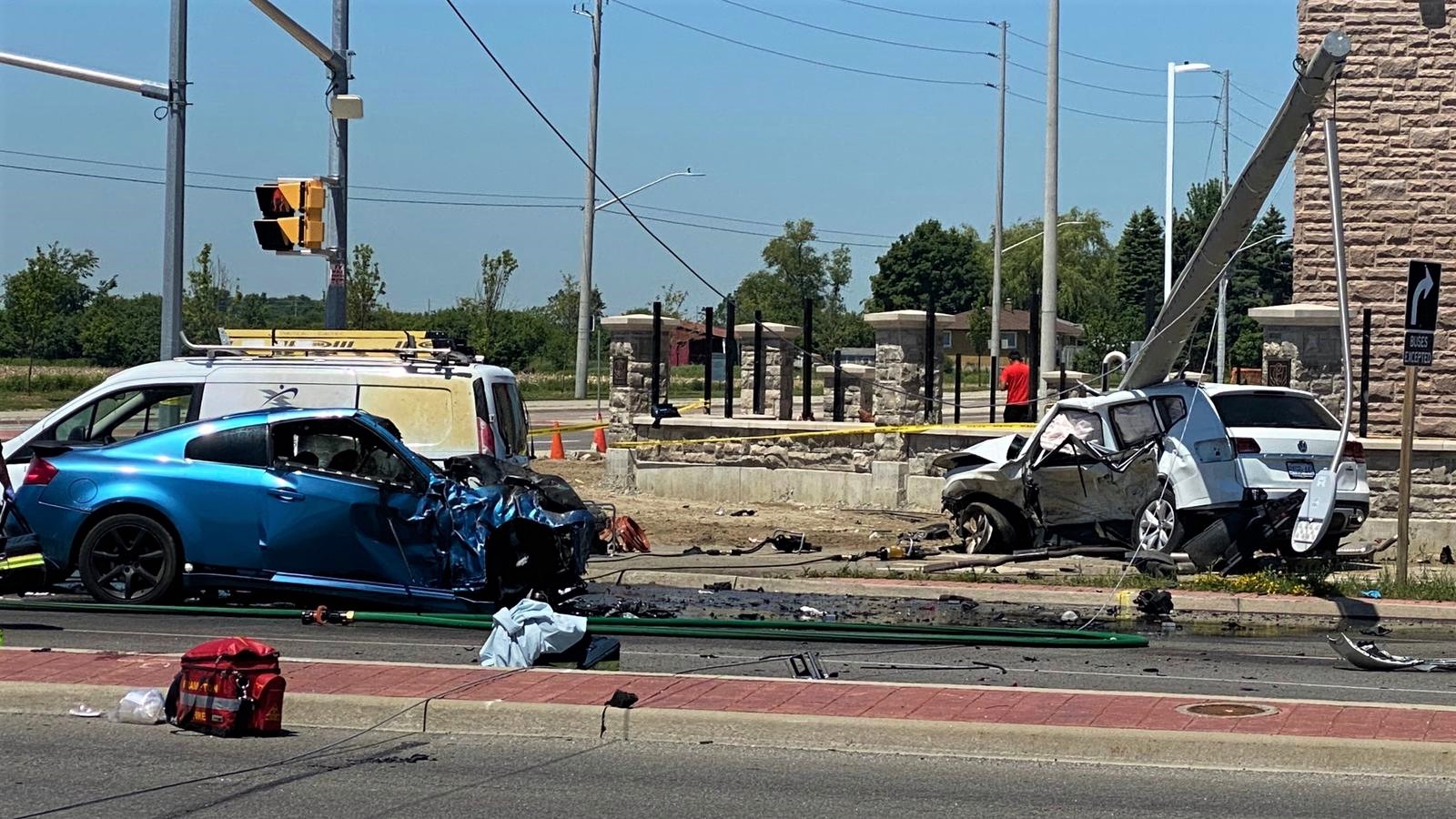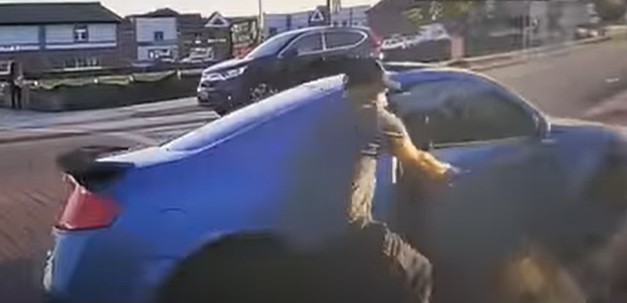
Man who killed Caledon family is fighting impaired driving charges but report shows THC in his system
A toxicology report completed on samples taken the day of a nightmarish accident that killed four members of the same family show driver Brady Robertson had drugs in his system.
The evidence was presented inside a Brampton courtroom this week as the trial continues. Robertson, now 21, has pleaded guilty to four charges involving dangerous driving but is fighting four additional charges of impaired driving and a dangerous driving charge involving an incident two days earlier.
On June 18, 2020, shortly after 12 noon, Robertson, a Caledon resident who was 20 at the time, drove down a major Brampton thoroughfare behind the wheel of a blue Infiniti G35 that slammed into a white Volkswagen Atlas driven by Caledon teacher Karolina Ciasullo, who was with her three young daughters. Her vehicle slammed into a light pole that crumbled on top of the SUV. They died from injuries sustained in the violent collision.

A photo posted to Facebook shows the wreckage.
Robertson was taken to Brampton Civic before getting transferred to St. Michael’s Hospital in Toronto. A toxicology report presented by forensic scientist, Betty Chow, showed blood drawn at 1 p.m. in Brampton Civic, roughly an hour after the June 18 accident, found Robertson had THC in his system. The legal limit allows for five nanograms per millilitre of blood. Robertson had 40 nanograms per millilitre of blood (the range of error is plus or minus three nanograms).
Fentanyl was listed as not detected in this sample but it showed up in the urine sample, along with other drugs, Chow said. THC was not detected in the urine sample.
A serum sample, a fluid part of blood, did not detect ethanol. Chow explained this is the chemical that makes alcohol intoxicating.
Chow said fentanyl can impair those driving a vehicle. It’s effect depends on how it's administered, how much gets in the blood, and the user's tolerance to it. If it is smoked or injected, the reaction will be quick and can last up to four hours after administration. If consumed orally, it can take up to 30 minutes to see effects and will last longer than being smoked or injected. Chow explained it can take up to two days to exit the bloodstream.
During cross-examination, Chow was questioned about the possible reasons for fentanyl in Robertson’s system and she agreed it could have been administered in hospital for his pain, after the crash caused serious injuries to the driver.
Peel police later found fentanyl and cannibis in Robertson’s car.
A second examination was conducted on blood drawn at 3:21 p.m when he had been transferred to Toronto. The analysis found 15 nanograms of THC per millilitre of blood (the error range is plus or minus one nanograms). Less than 1.3 nanograms per milliliter of fentanyl was also detected.

Karolina Ciasullo and her three daughters. (Image from GoFundMe)
Chow explained the difference in fentanyl levels could be due to when it was administered, as it could have been after the first blood test. If this wasn’t the case, Chow said these are two different samples in two separate tubes, which could have resulted in a different quality for each sample. She said drugs listed as not detected, but suspected of being used, means they could have been below the capacity the lab could detect (0.625 nanograms per milliliter in this case) but it’s possible a drug was still present in the blood. It’s also possible that a drug was detected but a final number for the level in the system couldn't be qualified.
THC, a chemical that is the main active ingredient of marijuana, can also affect motor skills, Chow explained. The user’s perception of time can be altered and it would be hard to focus on more than one thing while driving. It can also impact an individual’s ability to control a vehicle. When smoked or vaped, effects will be seen in minutes and can last upward of six hours after administration. If consumed orally, such as through a gummy, it takes longer to enter the bloodstream and effects may not be seen for up to an hour. It can last an estimated eight hours in the system.
On the first day of the trial this week, Robertson pleaded guilty to four counts of dangerous operations of a motor vehicle causing death. He pleaded not guilty to four counts of impaired operation causing death by drugs and one charge of dangerous operation of a motor vehicle in relation to a separate incident that took place two days earlier when video footage showed Robertson slumped in his driver’s seat driving recklessly up onto a Caledon sidewalk as shocked bystanders tried to stop him, before he snapped to and sped away.

A bystander tries to stop Brady Robertson when he drove up onto a Caledon sidewalk two days before he killed a Caledon family. (Screen grab from Twitter)
The agreed statement of facts show a Peel Regional Police officer noticed a blue Infiniti with no front license plate travelling northbound on Bramalea Road on June 18 and followed it all the way to the intersection of Torbram Road and Countryside Drive. The cruiser reached a speed of 105 kilometers an hour.
Behind the wheel of the Infiniti, Robertson, who had purchased the car 12 days earlier and never registered it, was driving at high speed on a main Brampton thoroughfare.

A court-supplied image shows the horrific afermath of the crash.
The Infiniti approached a red light when it reached the intersection of Torbram Road and Countryside Drive, swerved around stopped vehicles, toward the intersection. Robertson exited his lane into the left turning lane to avoid the cars before turning back toward the intersection just when the Volkswagen SUV was entering after the light turned green.
The Infiniti violently rammed into the driver’s side of the Volkswagen Atlas, with the Ciasullo family inside, sending it into a light standard which then crashed down right on top of the vehicle.
The Infiniti was engulfed by flames and its entire front half was completely smashed apart.
The SUV was driven by the 37-year-old mother. Her three daughters, six-year-old Klara; three-year-old Lilianna; and one-year-old Mila were in the back.
A collision reconstruction showed Robertson was driving 135-kilometres-an-hour in an area with a 70-kilometer speed limit. Five vehicles were towed from the scene, including the Infiniti, Volkswagen, and a police cruiser. The Atlas and Infiniti were seized as evidence and the latter was brought to a police garage for inspection six days later, Staff Sgt. Gary Carty, the investigation’s major case manager, said on the second day of the trial.
Six days after the crash, a search of the glove box found four pills. A test of a single pill showed it was fentanyl, according to the agreed statement of facts, alongside a baggy with 8.5 grams of cannabis.
All of this evidence could be thrown out as Robertson has filed a section 8 application under the Charter which prohibits unreasonable search or seizure. His application is scheduled to be heard Monday.

Brady Robertson, a 21-year-old Caledon resident, faces nine charges related to dangerous and impaired driving. (Image from Facebook)
Robertson was arrested at St. Michael’s Hospital on the same day and has remained in police custody ever since. His attempt to get bail was denied in August. Details were not publicly available due to a publication ban.
“The purpose of the ban is to preserve the rights of the defendant to a fair trial, and the presumption of innocence. Further, the ban prevents public dissemination of information or evidence so that jurors make their decisions based only on admissible evidence presented during the trial. It is also intended to maintain the integrity of the evidence of any potential witness who may be called to testify in the case,” Ontario’s Ministry of the Attorney General states.
Robertson’s Brampton trial continues next week as part of the first stage. November 1 to 9; and December 20 to 22 are the remaining two stages.
Email: [email protected]
Twitter: @nida_zafar
Tel: 416 890-7643
COVID-19 is impacting all Canadians. At a time when vital public information is needed by everyone, The Pointer has taken down our paywall on all stories relating to the pandemic and those of public interest to ensure every resident of Brampton and Mississauga has access to the facts. For those who are able, we encourage you to consider a subscription. This will help us report on important public interest issues the community needs to know about now more than ever. You can register for a 30-day free trial HERE. Thereafter, The Pointer will charge $10 a month and you can cancel any time right on the website. Thank you.
Submit a correction about this story


